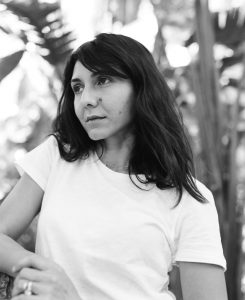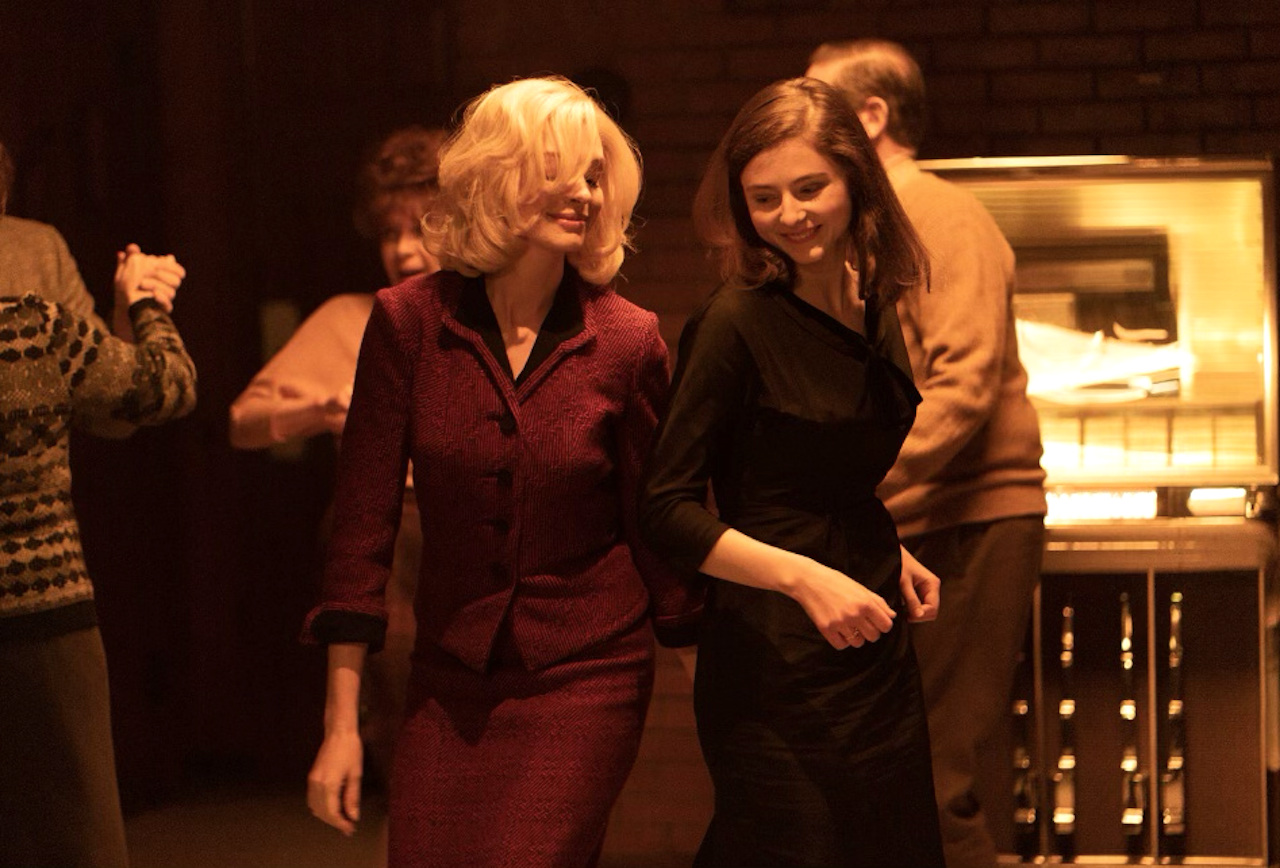“I always wanted to write for movies, but didn’t really admit it until I moved to Los Angeles and someone asked me if I wanted to write a movie,” says Ottessa Moshfegh, the novelist turned screenwriter behind Eileen. “I studied other movies and loved learning the new form.”
Ottessa’s screenplay credits include Causeway and Eileen and some of her novels are Eileen, My Year of Rest and Relaxation, Death in Her Hands, Lapvona, and McGlue. “It felt totally unnatural in the beginning,” she says of screenwriting.
“There’s two versions,” says her partner Luke Goebel, in regards to their origin story. “One was the dream and one was the reality. When we met, right from the beginning, we were talking about movies, dreaming about movies, which seemed more like play. Then, there was an opportunity.”
Ottessa wrote a draft of McGlue as an adaption, but Causeway, starring Jennifer Lawrence and Brian Tyree Henry, broke the mold for this new craft. “Reality suddenly came knocking with a pretty loud fist,” says Luke. For their partnership, proximity is a factor, jokes the couple, but it’s also the intangible effect of a “short-hand.” Ottessa says, “It’s really easy to say something or begin to say something and oftentimes, we don’t have to finish our sentences.”
“I feel comfortable saying I have this tiny shred of an idea and knowing it will be fostered and supported rather than just swatted away. In collaborating, you need to negotiate a lot. We do that constantly and it’s safe to agree or disagree, and see things from a new perspective.”

Ottessa-Moshfegh. Photo by Andrew Casey
This “shared psychic language” of a life together, “shared pain, pleasure and joy,” comes from “fertile grounds for seeds to grow.” For their latest project, Eileen, the story follows a woman’s friendship with a new co-worker at the prison facility where she works, but the friendship takes a sinister turn.
Adapting Eileen
“The spark of the idea of the novel came from a conversation I had very soon after I moved to Los Angeles around 2011,” begins Ottessa. “I was talking to a documentary filmmaker named Joshua Rofé who did a documentary called Lost for Life.”
The documentary showcased juveniles serving life in prison without parole and their victim’s families. “Could you forgive?” reads the tagline. “He had just done an interview with a man in prison who inspired the character Lee Polk (Sam Nivola). It was a story I couldn’t forget. I couldn’t put it down.”
“It was so upsetting and fascinating in the worst ways,” she says. “I decided to write a novel. I knew I wanted to bring a certain sensibility and a new kind of character into the foreground, but I also felt this pull back towards what was Lee’s story. That helped me imagine this tense, hidden world.”
As for the adaptation, Luke says, “I felt like there was so much to be done, moving from first person to third, the drama between characters, what had previously not been said, as it was from Eileen’s point of view, those characters have more to say.” They also added some regional comedy, which the writers describe as “deadpan of Massachusetts.”
Luke says, “I feel like they’re perfect mirrors” of the novel and the film. “They are reflections of one another in the best way. The book and the film are both radical.” Rather than looking at previous notes, they essentially started a new story based on what they both loved most from the book.
Logistically, the book had been optioned, but the movie had never gotten made. When Ottessa got the IP back, they met director William Oldroyd (Lady Macbeth). “It all happened at exactly the right moment. We never saw the earlier script. It felt like the right thing at the right time.”
The Writing Process
“We had meetings with Will, got our shared vision, and went to the coast of Oregon, a little town, and set up shop in a little house,” says Luke. “We wrote for 12,13, 14-hour days. Taking turns at the computer. Just writing.”
Together, they also did some “acting and bad acting” jokes Luke. “As we create dialogue and scenes, you get to be characters and try things out.” With each line delivered, they allow themselves to get more animated and excited.”
In terms of balance in the partnership, Ottessa notes that when she writes alone, she tends to rush, and move forward quickly with plans to move back or revisit. But, with Luke, he encourages them to stay in moments longer to figure out solutions. “I wouldn’t say Luke is a perfectionist, but he obsesses until we know we can move on.”
Ottessa’s strengths lie in story and pacing. Luke steps back in for the bird’s eye view of theme and structure. “Ottessa is amazing at revision. A film works one way, but she can move it so it falls into place.” The other strength of the dual conversation is that it begs you to explain ideas to another set of eyes.

Luke Goebel
“Having to talk about things, you end up developing the ideas so they get more layered, interesting, and specific.” Ottessa is very literal with her descriptions while Luke is more abstract. He says he’ll have to explain it in concrete details to “return it to center.”
When they’re not writing, at least in the case of Eileen, they would walk the dogs down the beach as wildfires filled the air with smoke up and down the west coast. “But we don’t really hit the escape valve. We don’t off pressure much.”
Luke says, “We’ll read it again. We don’t hit walls where we can’t come up with anything. We have a lot happening. It’s more like choosing which exciting thing is the absolute right thing. It’s revising, not struggling to generate. But, other times, you just have to wait. You have to live with the characters long enough to understand them.”
Enter the Actors
In the film, Thomasin McKenzie stars as Eileen Dunlop and Anne Hathaway co-stars as Rebecca. “Reading the book and the script, Otessa’s style of writing, is evocative and visceral,” says Thomasin. “It felt like something I could feel, in my bones.” Anne’s initial attraction to the work came from “how monstrous things can be, despite a pretty surface.”
“Eileen and Rebecca were so different,” says Thomasin. “I was thinking about the fact that Eileen wanted to be as similar to Rebecca as she possibly could. She was infatuated with her, in love with her.” For her specific role, Anne says she doesn’t think of it in terms of character but as “a human being with a lot of complexities.”
She continues, “The thing that was unusual was seeing a female character able to explore the grotesque. That’s not something that a lot of space is made for. And, to explore a sense of violence and the release of it.”
Beyond the script, Thomasin did a massive amount of research for the role. “It’s the part of filmmaking I love the most. Having the book was such an incredible resource. I took the book and highlighted sentences, phrases, observations about Eileen, how she felt about herself, her dad, Rebecca, the women working with her at the prison, everyone.”
Then, she took the highlighted notes, put those into a document and organized it by categories. She actually sent the document, the notes from the book, to a clinical psychologist who had worked in a prison and she helped Thomasin decipher what was going on with Eileen. “She shared stories of her experience of working at a juvenile boy’s prison and how she felt in that environment.”
In terms of advice for screenwriters to create compelling roles for actors, Anne says, “Plot serves character and not the other way around, but not everyone agrees with that,” she jokes. “Otherwise, just be specific. I was working with Director James Gray [on Armageddon Time] and he said he hoped to make films that are ambiguous but never vague. Finding that authentic, specific thread to each character is everything.”
Manifesting Creativity
“I don’t know if it’s something you can teach,” says Ottessa about their obsessive nature. “The tendency to expect more from yourself and also trust the process, that draft number one, as much as you think you nailed it, there’s always more.” Luke adds, “Ottessa has the most faith in her connection to creativity as anyone I’ve ever met.”
Luke wrestles more with his own perfectionism. “I don’t expect a first draft or even a tenth draft to be right, but I’m rarely happy,” he jokes. “This might be a game I’m playing with myself,” she says, “But I have nothing to do with this. I’m just typing. If I don’t know the answer yet, I assume the universe will deliver an answer when I’m supposed to have it.”
For Ottessa, it makes sense in hindsight, but Luke says he actually sees it in real time. “It’s almost like possession,” he jokes. She adds, “I just really believe that we live through time in a linear way, but art doesn’t. Anything that I expect to finish exists in its finished form in the future. I’m just not there yet. I’m trying to predict what it may be. I’m producing, not doing. That takes me off the hook.”
This manifestation approach also rises to the surface in a game they play together. “We play this game that’s like… ‘Oh, I know…’ but you don’t know,” jokes Ottessa. “Oh, I know!” adds Luke. The idea here is that spontaneity of the phrase requests an idea from the universe by simply uttering the phrase. “Oh, no, no, I know…and you start a finish and expect the universe to finish it. The variety of our two minds, if we can find common grounds that excites both of us, we know we’re on to something.”
This interview has been condensed. Listen the full audio interview with Ottessa Moshfegh & Luke Goebel here, and stars Anne Hathaway & Thomasin McKenzie here.

